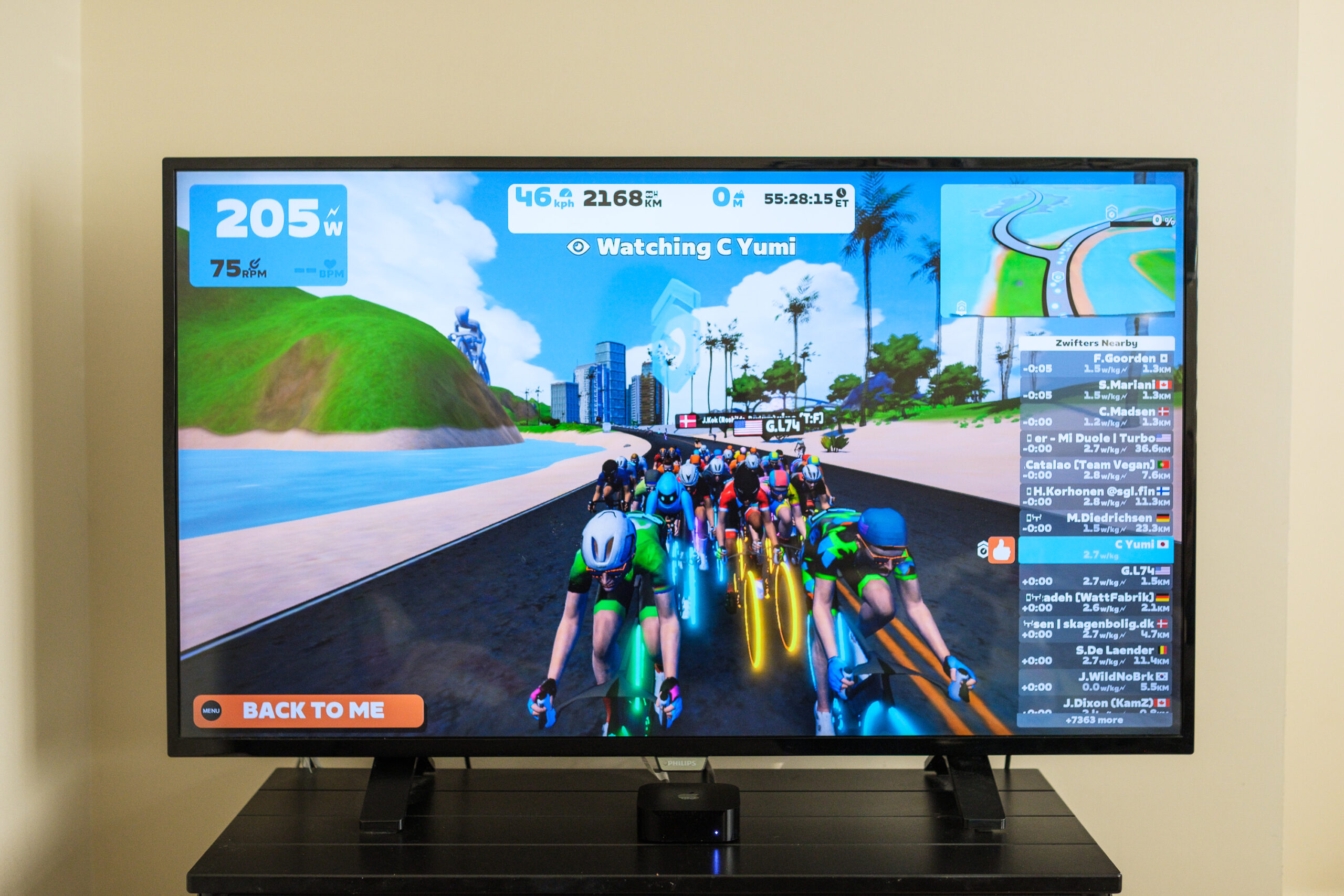Can you play Zwift on Apple Vision Pro? Well, Zwift is going to find out…
Apple has launched its mixed-reality headset, the Vision Pro, but what does it mean for the future of cycling?
Marketed as a ‘spatial computer’, Apple claims the Vision Pro will revolutionise the way we interact with computers and apps.
Could this signal the advent of a new mixed- or virtual-reality indoor training age? Might we one day use mixed-reality headsets while riding outside?
With Zwift confirming to BikeRadar that it is planning to do some early testing with Apple Vision Pro, let’s find out.
What is Apple Vision Pro?
First of all, it’s worth defining what Apple Vision Pro is and what it isn’t.
Apple Vision Pro is a mixed-reality headset that runs Apple’s new visionOS operating system.
It uses a range of cameras and sensors, both inside and out, to track a user’s eyes, hands and voice.
This then enables it to overlay apps, windows and virtual desktops in a 3D interface, over a live video stream or ‘passthrough’ of the real world.

This is distinct from ‘virtual reality’ headsets, which block out the real world and, as the name suggests, immerse users in a fully virtual world.
Apple has also shied away from referring to it as an ‘augmented reality’ headset, which incorporates computer-generated content into the real world (think Pokémon Go). The difference here is more semantic, however.
Prices for Apple Vision Pro, which went on sale this week, start from $3,499 for a model with 256GB of storage and rise to $3,899 for a 1TB model.
At the time of writing, Apple Vision Pro is only available in the United States.
Can Apple Vision Pro be used with Zwift?

While it runs Apple’s new visionOS, Vision Pro is also compatible with iOS and iPadOS apps (although app developers were offered an opt-out from compatibility, if desired).
The question many tech-savvy cyclists will be asking is whether Apple Vision Pro is compatible with Zwift, the popular virtual indoor cycling app?
Zwift told BikeRadar that while it hasn’t yet done any specific development to optimise its app for visionOS, it also hasn’t opted out of compatibility, so the app “should work fine”.
Similarly, other iPad-compatible apps, such as Rouvy, Wahoo SYSTM and TrainerRoad, should also work on Apple Vision Pro (assuming the brands haven’t specifically opted out).
Zwift also says its co-founder and head of product, Jon Mayfield – a former video game designer – has acquired a Vision Pro headset and will be investigating using Zwift with it soon.

Coincidentally, Zwift in virtual reality is something the brand has explored before. Back in 2017, Zwift demoed a prototype Zwift VR app at Eurobike.
Paired with an Oculus Rift VR headset (a predecessor to the latest Meta Quest 3 headset), the Zwift VR app put the rider in a first-person view, as opposed to the third-person viewpoint typically adopted in-game.
Riders could then move their head to look around in-game, for a more realistic and immersive experience.

When asked whether this is something it’s still actively exploring, Zwift said the main challenge is the form factor of current VR headsets – “they simply get too hot and steamed up” during hard workouts and intense efforts.
Nevertheless, Zwift confirmed this is a space it is “watching”. Until the hardware required is better-optimised for high-intensity sport (and, presumably, a bit more accessibly priced), though, it’s unlikely we’ll see a fully realised Zwift app for visionOS any time soon. “The hardware isn’t where it needs to be for Zwift just yet,” a Zwift spokesperson told BikeRadar.
How else might Apple Vision Pro change cycling?

But what if you prefer your indoor training to be boring?
Beyond simply putting riders in an immersive virtual world, it’s also possible to imagine other ways headsets such as Apple’s Vision Pro could integrate themselves into our cycling lives in a future tech utopia (dystopia?).
Given Apple already has a web browser and podcast app, there’s nothing to stop you from using Apple Vision Pro to browse BikeRadar.com in glorious high definition, or to listen to the BikeRadar podcast while relaxing in a calming virtual environment.
If that’s not enough, though, perhaps we’ll all soon be maintaining our bikes with artificial-intelligence assisted instructions overlaid on the components.

Or maybe one day we’ll be riding around in the real world with an Apple Vision Pro strapped to our faces like today’s cycling glasses, replacing the functionality of bike computers with a true heads-up display.
Assuming this so-called ‘outdoor cycling’ is something people still wish to do in the future, of course.
Notably, something like this has been tried before. Recon’s Jet smart sunglasses saw the brand attempt to pair a set of standard cycling glasses with a small heads-up display.
Naturally, it didn’t offer the same ‘spatial computing’ capabilities as Apple’s Vision Pro; however, the form factor was undoubtedly more appropriate for use on a bike.
Unsurprisingly, Apple doesn’t seem to have paid much attention to the needs of cyclists when designing its first mixed-reality headset.
Perhaps, once the early adopters have had their say, we’ll get a more sports-oriented version of Apple Vision Pro, or an altogether new augmented reality further down the line.